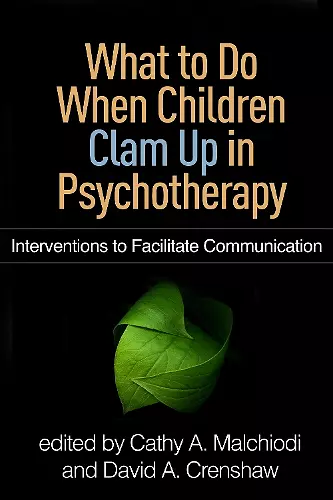What to Do When Children Clam Up in Psychotherapy
Interventions to Facilitate Communication
David A Crenshaw editor Cathy A Malchiodi editor
Format:Hardback
Publisher:Guilford Publications
Published:13th Jul '17
Currently unavailable, and unfortunately no date known when it will be back
This hardback is available in another edition too:
- Paperback£29.99(9781462530427)

Therapists who work with children and adolescents are frequently faced with nonresponsive, reticent, or completely nonverbal clients. This volume brings together expert clinicians who explore why 4- to 16-year-olds may have difficulty talking and provide creative ways to facilitate communication. A variety of play, art, movement, and animal-assisted therapies, as well as trauma-focused therapy with adolescents, are illustrated with vivid clinical material. Contributors give particular attention to the neurobiological effects of trauma, how they manifest in the body when children "clam up," and how to help children self-regulate and feel safe. Most chapters conclude with succinct lists of recommended practices for engaging hard-to-reach children that therapists can immediately try out in their own work.
"This is one of those rare clinical books that not only will occupy a prominent place on the therapist's bookshelf, but also will be reached for time and time again between sessions. It is destined to be a cherished resource for child and adolescent therapists. Like having a cadre of expert supervisors at one's side, the volume successfully guides readers through one of the most common yet challenging types of treatment impasse, while expanding ideas of what therapy can look like. Innovators in the field offer sure-fire ways of engaging even the most reticent young people."--Craig Haen, PhD, private practice, White Plains, New York
"Psychotherapy with children can be an arduous and challenging process. Malchiodi and Crenshaw have provided an important, informative resource for child therapists. Regardless of the reader's therapeutic orientation, this book offers a wealth of cutting-edge ideas and strategies. Whether you are an experienced clinician or still in training, this unique volume is a valuable guide."--Sam Goldstein, PhD, Department of Psychiatry, University of Utah School of Medicine; Clinical Director, Neurology, Learning, and Behavior Center, Salt Lake City
"This is the best current book on a familiar treatment issue in child therapy. Honest, clear, and informative, the chapters offer multiple perspectives on how to facilitate children's communication in creative and insightful ways. Each chapter contains detailed hands-on applications. As a graduate educator in play therapy and expressive art therapy for more than 36 years, I am refreshed to find a book that provides even the neophyte therapist with such usable, inviting intervention strategies."--Julia Byers, EdD, Division of Expressive Therapies (Emerita), Lesley University
"The title immediately lets the reader know that this is a practical, accessible book. Malchiodi and Crenshaw have assembled leading experts to take us on a journey of discovering the impact of maturation, brain development, trauma, and culture on children’s communication styles. The volume presents models that highlight the primacy of creativity and relationship when counseling children. I recommend this book to counselors and therapists who wish to enter the world of children in the most effective ways, and as a complementary text for any course on child and adolescent counseling."--Dee C. Ray, PhD, LPC-S, NCC, RPT-S, Director, Center for Play Therapy, and Professor, Counseling Program, University of North Texas -Each chapter concludes with a list of best practices to guide the therapist through implementing the recommended approaches. Clinical educators and supervisors will find this book to be a valuable text to introduce trainees and supervisees to the principles and processes of child psychotherapy. Therapists new to working with children will appreciate the blend of theory and specific suggestions illustrated by engaging clinical examples to promote their understanding of both the content and process of dealing with silence in sessions. The book will also provide experienced therapists with the opportunity to update their knowledge of current best practices in assessing and treating silenced child clients.--American Journal of Play, 1/26/2018
ISBN: 9781462530434
Dimensions: unknown
Weight: 530g
247 pages